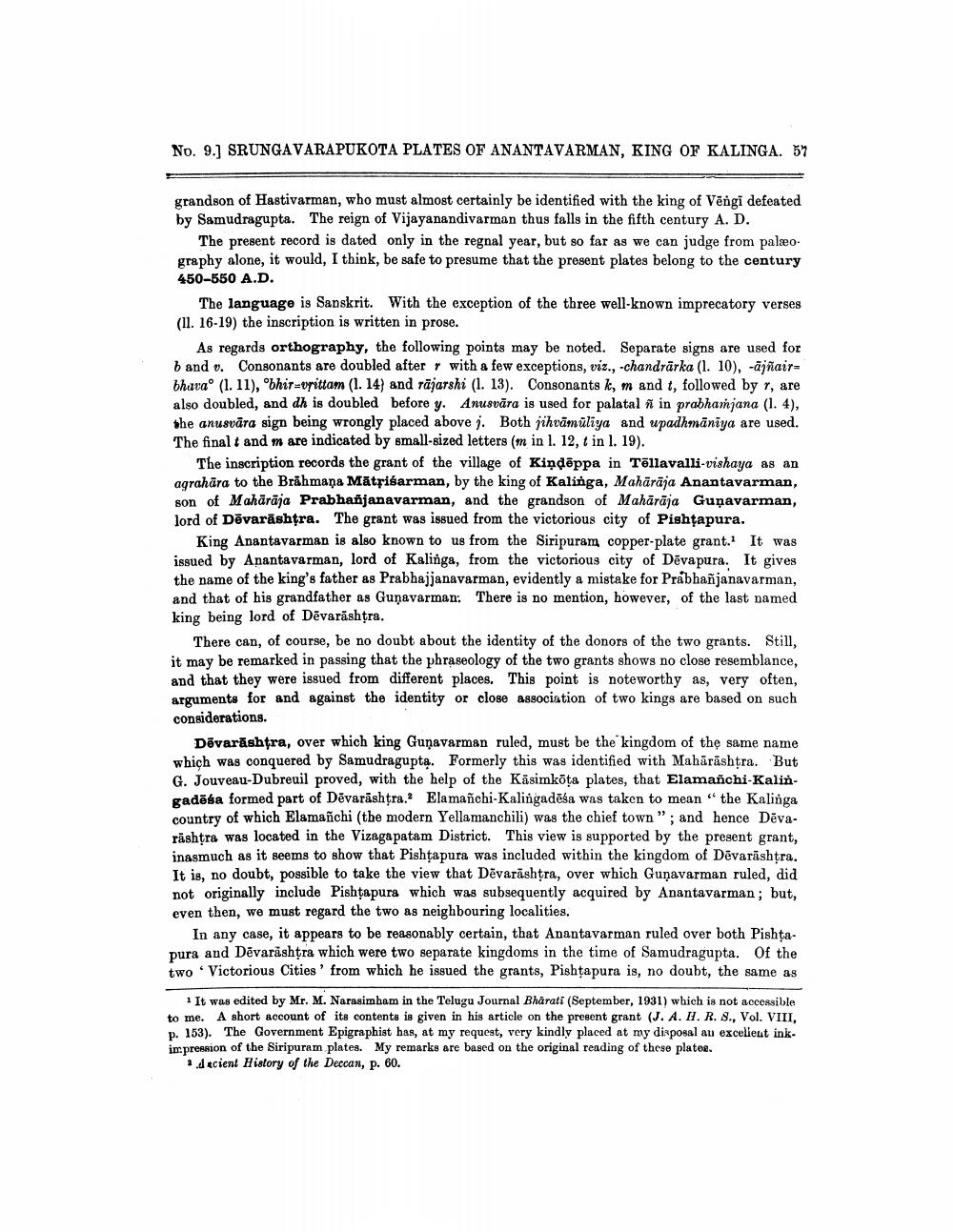________________
No. 9.) SRUNGAVARAPUKOTA PLATES OF ANANTAVARMAN, KING OF KALINGA. 57
vrandson of Hastivarman, who must almost certainly be identified with the king of Vengi defeated by Samudragupta. The reign of Vijayanandivarman thus falls in the fifth century A. D.
The present record is dated only in the regnal year, but so far as we can judge from palæography alone, it would, I think, be safe to presume that the present plates belong to the century 450-550 A.D.
The language is Sanskrit. With the exception of the three well-known imprecatory verses (11. 16-19) the inscription is written in prose.
As regards orthography, the following points may be noted. Separate signs are used for b and u. Consonants are doubled after r with a few exceptions, viz., -chandrārka (1. 10), -ājñairbhavao (1. 11), "bhir-upittam (1. 14) and rājarshi (1. 13). Consonants k, m and t, followed by r, are also doubled, and dh is doubled before y. Anusvāra is used for palatal ni in prabhamjana (1. 4), the anusvāra sign being wrongly placed above j. Both jihvāmūliya and upadhmāniya are used. The finalt and m are indicated by small-sized letters (m in l. 12, t in l. 19).
The inscription records the grant of the village of Kiņdāppa in Tõllavalli-vishaya as an agrahāra to the Brahmaņa Mātrisarman, by the king of Kalinga, Mahārāja Anantavarman, son of Mahārāja Prabhañjanavarman, and the grandson of Mahārāja Gunavarman, lord of Dēvarāshtra. The grant was issued from the victorious city of Pishtapura.
King Anantavarman is also known to us from the Siripuram copper-plate grant. It was issued by Anantavarman, lord of Kalinga, from the victorious city of Dēvapura. It gives the name of the king's father as Prabhajjanavarman, evidently a mistake for Prabhañjanavarman, and that of his grandfather as Guņavarman: There is no mention, however, of the last named king being lord of Dēvarashtra.
There can, of course, be no doubt about the identity of the donors of the two grants. Still, it may be remarked in passing that the phraseology of the two grants shows no close resemblance, and that they were issued from different places. This point is noteworthy as, very often, arguments for and against the identity or close association of two kings are based on such considerations.
Dēvarashtra, over which king Gunavarman ruled, must be the kingdom of the same name which was conquered by Samudragupta. Formerly this was identified with Mahārāshtra. But G. Jouveau-Dubreuil proved, with the help of the Kāsimkoța plates, that Elamanchi-Kalingadēsa formed part of Dēvarāshtra. Elamañchi-Kalingadēša was taken to mean "the Kalinga country of which Elamanchi (the modern Yellamanchili) was the chief town"; and hence Dēvarāshtra was located in the Vizagapatam District. This view is supported by the present grant, inasmuch as it seems to show that Pishtapura was included within the kingdom of Dēvarāshtra. It is, no doubt, possible to take the view that Dēvarāshtra, over which Guņavarman ruled, did not originally include Pishtapura which was subsequently acquired by Anantavarman; but, even then, we must regard the two as neighbouring localities.
In any case, it appears to be reasonably certain, that Anantavarman ruled over both Pishtapura and Dēvarashtra which were two separate kingdoms in the time of Samudragupta. Of the two Victorious Cities' from which he issued the grants, Pishtapura is, no doubt, the same as
It was edited by Mr. M. Narasimham in the Telugu Journal Bharati (September, 1931) which is not accessible to me. A short account of its contents is given in his article on the present grant (J. A. H. R. S., Vol. VIII, p. 153). The Government Epigraphist has, at my request, very kindly placed at my disposal an excellent inkin pression of the Siripuram plates. My remarks are based on the original reading of these platea.
decient History of the Deccan, p. 60.




